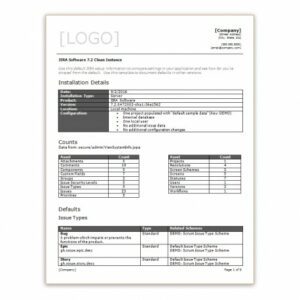How many custom fields do you have? For most of us the answer is: too many! With research and diligence, you can clean up your duplicate and unused custom fields and get your count down to a manageable number.
The first step in any clean up process an audit. You need to understand what fields your application has and how much that differs from the default Jira set up. Use the free Jira Clean Instance worksheet to compare your application to a default installation. Use this to get a count of all your standard and custom fields.
There are a few ways to approach your audit. You can do a manual examination, use an add-on from the Atlassian Marketplace, or use a combination of both. For helpful add-ons, check out: Cleaner for Jira, Custom Fields Usage for Jira (Server only), and Admin Tools for Jira (Server only). Jira Data Center users can leverage the built-in Custom Fields Optimizer.
While these plugins can help tremendously with your research, only a human can determine the value of a specific custom field for your organization.
Examination
Next, make a list of all field names and types for examination. Copy the all the fields on your Custom Fields admin page and paste them into Excel or Confluence. Use the free Jira Custom Field Audit worksheet to enter your data, collect your research findings, and total the fields to remove. Now that you have the list, start researching and classifying each field
First, flag the fields created by Jira. These fields are likely needed, locked and can’t be removed. Don’t spend time researching these.
Second, flag the fields created by an add-on or plugin. When plugins are deactivated or uninstalled, their custom fields remain. You’ll need to determine if data in those fields needs to be retained.
Finally, flag all the fields created by admins. These will require the most research.
Research
It’s time to find out everything you can about each add-on or admin created custom field. Start by determining which plugin created which field and add this information to your spreadsheet. Look for clues in the following places:
- Jira’s application audit log,
- the add-on audit log,
- the field’s description on the “Manage add-ons” admin page,
- login as an end user, use the add-on, and see which fields are displayed,
- or check the plugin’s documentation.
Next, research the remaining admin created fields. Are there duplicates, misspellings, or poor naming choices? Are any fields associated with unused projects? How is each field used today?
Determine the scope of each field’s use by looking in the following places:
- the Custom Fields admin page,
- on screens,
- in workflow behaviors (conditions, validators, and post functions),
- and in user JQL queries.
TIP: For each field, do a JQL query and note how many issue were found, how many issues are in unused projects, and the business value of the data returned. Just because data is returned doesn’t mean it’s still useful!
Finally, check how many users have saved queries using the custom field. If you have Jira Server or Data Center, and read-only access to the Jira database, you can get this information from the “reqcontent” column in the “searchrequest” table.
Next Steps
Now that you’ve uncovered some unneeded fields, it’s time to take action! We’ll cover the clean up process in an additional article in this custom fields series.
Take the Jira Custom Fields & Clean Up Course!
 Learn how custom fields work, how to determine when a new custom field is warranted, and how to clean up custom fields added by application admins and add-ons.
Learn how custom fields work, how to determine when a new custom field is warranted, and how to clean up custom fields added by application admins and add-ons.
Take the 20 minute online course


Pingback: Time to Decide: What to do with all those Jira Custom Fields – Strategy for Jira®
Pingback: Deleting, Hiding & Merging Jira Custom Fields – Strategy for Jira®
Pingback: Keeping It Clean: Containing Jira Custom Field Growth – Strategy for Jira®
Pingback: 7 Custom Fields Every Jira Application Needs - Strategy for Jira®